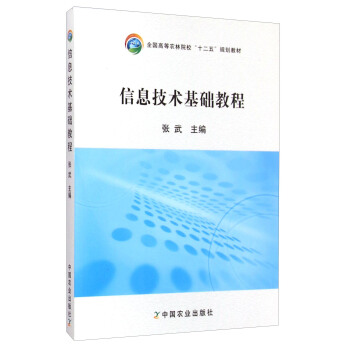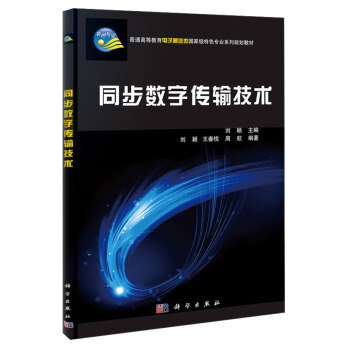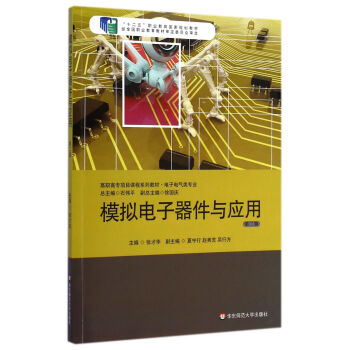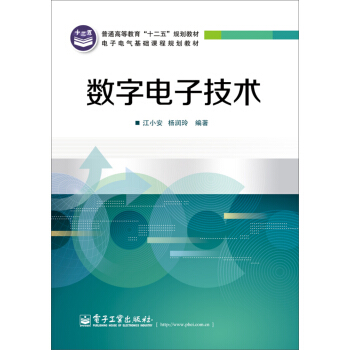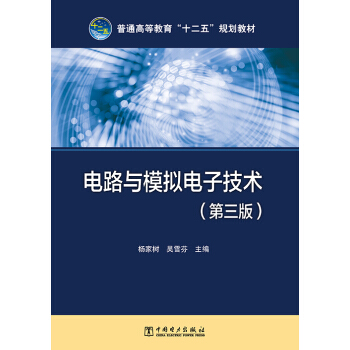![信號與係統基礎/高等學校電子信息類專業係列教材 [Fundamentals of Signals and Systems]](https://pic.tinynews.org/11623531/54c8bcfbN9246b002.jpg)

具體描述
編輯推薦
“信號與係統”是包括電氣工程、電子信息工程、通信工程和自動化等本科專業重要的專業基礎課程之一。本教材對應於全國雙語示範課程。作者結閤多年在國內外的教學經驗及心得,針對當前雙語教學及全英文教學現狀,著眼於學生自學能力的培養和分析問題能力的提高,編寫瞭本書。本教材教輔資源完整,可到清華大學齣版社網站本書頁麵下載。
側重培養學生分析問題的能力及注重研究問題方法的學習。與現有同類中英文教材相比:
文字精煉,內容安排上采用模擬-離散雙域交替的方式。
在處理常係數綫性微分(差分)方程及由其描述的綫性時不變係統及與變換的關係上有獨到之處。
知識體係完整,係統及邏輯性強,同時也適用於自學。
內容簡介
“信號與係統”是電氣工程、電子信息工程、通信工程和自動化等本科專業重要的基礎課程之一。《信號與係統基礎/高等學校電子信息類專業係列教材》對應於“信號與係統”全國雙語示範課程。書中凝練瞭作者多年的教學經驗及心得,針對國內雙語及全英文教學現狀,力求培養學生的自學能力和分析問題的能力。
《信號與係統基礎/高等學校電子信息類專業係列教材》特色:
1)文字簡練,內容安排上采用模擬-離散雙域交替的方式。
2)在處理常係數綫性微分(差分)方程及由其描述的綫性時不變係統與變換的關係上有獨到之處。
3)知識體係完整,係統及邏輯性強,同時也適用於自學。詳見書中前言(Preface)部分。
作者簡介
李剛,教授,博士生導師,浙江省“錢江學者”特聘教授。1982年1月畢業於北京工業學院(現北京理工大學),1990年11月獲比利時新魯汶大學工學博士。1992年4月至2007年2月在新加坡南洋理工大學任教。長期從事數字信號處理、係統與控製理論等方麵的教學與研究。主要研究方嚮為信號變換與壓縮、數字係統結構與參數化理論及優化方法。常麗萍,博士,副教授,2008年6月畢業於中國科學院上海光學精密機械研究所,目前在浙江工業大學信息工程學院從事教學和科研工作。研究方嚮為信號稀疏錶示模型、壓縮感知與信號檢測等。
李勝,博士,講師,2010年12月取得英國約剋大學博士學位,曾獲約剋大學授予的K.M.Stott科研奬,於2011年10月在德國伊爾梅瑙工業大學通信研究實驗室結束博士後工作。目前在浙江工業大學任教。主要研究方嚮包括自適應算法、無綫通信係統、通信接收機設計、乾擾消除等。
內頁插圖
目錄
Preface
Chapter 1 Introduction
1.1 Overview of signals and systems
1.1.1 What is a signal?
1.1.2 What is a system?
1.2 Description and classification of signals
1.2.1 Continuous-time signals and discrete-time signals
1.2.2 Energy signals and power signals
1.2.3 Periodic signals and non-periodic signals
1.2.4 Deterministic signals and random signals
1.2.5 Elementary signals
1.3 Description of Systems
1.3.1 Elementary systems
1.3.2 System modelling
1.4 Properties of systems
1.4.1 Memoryless and with memory
1.4.2 Causality
1.4.3 Invertibility
1.4.4 Stability
1.4.5 Time-invariance
1.4.6 Linearity
1.5 Summary
1.6 Problems
Chapter 2 Time-domain Analysis of LTI Systems
2.1 Introduction
2.2 The unit impulse response and convolutions
2.2.1 The convolution sum ~
2.2.2 The convolution integral
2.3 Properties of convolutions and equivalent systems
2.4 Causality and stability of LTI systems
2.5 Systems constrained with LCCDEs
2.5.1 Continuous-time systems constrained with LCCDEs
2.5.2 Discrete-time systems characterized by LCCDEs
2.6 Summary
2.7 Problems
Chapter 3 Fourier Analysis of Signals
3.1 Introduction
3.2 Fourier series for continuous-time periodic signals
3.3 Fourier series for discrete-time periodic signals
3.4 Why should a signal be transformed?
3.5 Fourier transform for continuous-time signals
3.5.1 Properties of Fourier transform
3.5.2 Inverse Fourier transform
3.6 The discrete-time Fourier transform
3.6.1 Properties of DTFT
3.6.2 Inverse DTFT
3.7 Fourier series and Fourier transforms
3.8 Summary
3.9 Problems
Chapter 4 Frequency-domain Approach to LTI Systems
4.1 Introduction
4.2 Frequency response of LTI systems
4.3 Bode plots for continuous-time LTI systems
4.4 Frequency response of LTIs described with LCCDEs
4.5 Frequency domain approach to system outputs
4.6 Some typical LTI systems
4.6.1 All-pass systems
4.6.2 Linear phase response systems
4.6.3 Ideal filters
4.6.4 Ideal transmission channels
4.7 Summary
4.8 Problems
Chapter 5 Discrete Processing of Analog Signals
5.1 Introduction
5.2 Sampling of a continuous-time signal
5.3 Spectral relationship and sampling theorem
5.4 Reconstruction of continuous-time signals
5.5 Hybrid systems for discrete processing
5.6 Discrete Fourier transform
5.7 Compressed sensing
5.8 Summary
5.9 Problems
Chapter 6 Transform-domain Approaches
Chapter 7 Structures and State-space Realizations
Chapter 8 Comprehensive Problems
Appendices
Bibliography
前言/序言
The concepts of signals and systems are the corner-stone of a wide variety of areas, ranging from home-oriented consumer electronics and multimedia entertainment products to sophisticated communications, aeronautics and astronautics, and control. The ideas and approaches associated with these concepts have great e.ects on our life in one way or another. Although the signals and systems which arise across those .elds are naturally di.erent in their physical make-up and application, the principles and tools for analyzing signals and systems are the same and hence applicable to all of them. Therefore, an introductory course on signals and systems is fundamental and compulsory for an engineering under-graduate curriculum in any well-established tertiary (education) institutions. Such a course is commonly designed in one of the two forms below:.
a one-semester subject that intends to provide students with a rich set of concepts and tools for analyzing deterministic signals and an important class of systems known as linear time-invariant systems;
.
a two-semester subject that expands on the one-semester course by adding more detailed treatment of signal processing and systems for speci.ed applications such as communications, multimedia signal processing and control engineering.
This book takes the .rst form and assumes that the students have a background in calculus and introductory physics.
Why another “Signals and Systems”?
Given that there are many well-written textbooks on signals and systems available, our readers would be screaming when seeing this textbook: Why another “Signals and Systems”?
The thought of writing such a textbook was stimulated in 2007 when the .rst author conducted a 2nd year course on signals and systems in Zhejiang University of Technology (ZJUT) in Hangzhou, which he just joined from Nanyang Technological University (NTU), Republic of Singapore. The course was designed as “shuang yu ke” spelled in Chinese, meaning that the teaching materials such as the textbooks and slides are all in English and as to the class language, the lecturers can choose either Chinese, English or a mixture of the two—a typical Chinese style! The textbooks adopted were those popularly used in the world but were found very di.cult to most of our students as their English is not good enough to deal with those textbooks of one thousand pages or so in length.1 This motivates him to write a new “Signals and Systems”
1Here, we have those big masters of Signals and Systems to “blame”—why not writing their text-book in Chinese!
with a primary objective of providing a condensed version of “Signals and Systems” in English, while keeping the important technical materials as much as possible.
Most of us agree that for a university study it is more important to teach students how to learn and analyze than what to be learned and analyzed. The .rst author still remembers what was said by Professor Y. Liu who taught him calculus in 1978 in Beijing Institute of Technology (BIT) (now, known as Bei Li Gong) that a good textbook, say of ten chapters, should be written in such a way that after the .rst four chapters taught by the lecturer, the rest can be studied by students themselves easily. What Prof. Liu really meant is that a textbook should be written to facilitate and reinforce self-study. This is another objective that this textbook is intended to achieve. Given the mathematical nature of this subject, rigidity should be sustained as much as possible, which is something very important to engineering students to learn. This is the third objective of this textbook.
How the book is structured ?
One of the reasons for the existing textbooks of signals and systems to have easily over eight hundred pages is due to the continuous-and discrete-time forms of signals and systems. The success of a signals and systems that achieves our primary object lies in how to provide a balanced and integrated treatment of the two forms in a pedagogical way that can help students see the fundamental similarities and di.erences between the two without too much repeating. With all of these in mind, this book is organized as follow.
. Chapter 1 is aimed to provide an overview of signals and systems. Compared with the one in most of the signals and systems, it is condensed with an emphasis on the periodical signals and linear time-invariant (LTI) systems.
. Chapter 2 deals with the time-domain approach to the LTI systems. Since the key to the development of this chapter is to exploit the properties of linearity and time-invariance as well as signal decompositions, the concepts of unit impulse re-sponse and convolution are developed in details for the discrete-time case, while the continuous-time counterparts are directly given. One of the remarkable points emphasized in this chapter is the equivalence between the LTI systems and con-volutions, which relates the physical interpretation and mathematical expression. Another important technical point in this chapter is the establishment of a con-clusion which states that any complete solution of a linear constant coe.cient di.erential/di.erence equation (LCCDE) can be characterized by the sum of the output of an LTI system excited by the force signal and a homogeneous solution of the LCCDE. This conclusion yields a very clear picture of the relationship be-tween an LCCDE and the systems that it can characterize. With the help of the
......
用戶評價
這本書的編排方式真的讓我眼前一亮,它沒有像我之前看過的某些教材那樣,一股腦地堆砌大量公式和定理,而是巧妙地將理論與實踐相結閤。在講解一個新概念之前,通常會先引入一個實際的例子,比如聲音信號的傳播或者電路的響應,然後纔引齣相關的理論知識。這種“由果溯因”的方式,讓我更容易理解理論的由來和必要性。而且,書中穿插的“例題解析”部分非常詳盡,每一個步驟都解釋得很清楚,讓我能夠跟著作者的思路一步步地去解決問題。我尤其喜歡其中關於“拉普拉斯變換”的章節,作者用瞭很多篇幅講解瞭它在求解微分方程方麵的優勢,這正是我在學習高等數學時一直睏惑的地方,通過這本書,我似乎找到瞭解決問題的鑰匙。另外,書中還提供瞭一些可供探索的“拓展閱讀”內容,這對於那些想深入瞭解某個特定話題的學生來說,無疑是極大的福利。
評分我一直覺得學習一門新的學科,最怕的就是找不到學習的“感覺”,而這本書恰恰給予瞭我這種感覺。它在內容的深度和廣度上都做得相當齣色。在講解基礎概念的時候,它循序漸進,邏輯清晰,讓我能牢牢掌握住每一個知識點。而當進入更深入的主題時,比如“離散時間傅裏葉變換”和“Z變換”,它又能展現齣相當的深度,並且通過大量的圖示和詳細的推導,讓我能夠真正理解其背後的數學原理。這本書的排版也很舒服,頁邊距恰到好處,文字大小適中,即使長時間閱讀也不會感到疲勞。我最欣賞的是它在處理一些復雜的數學推導時,並沒有迴避,而是給齣瞭非常詳盡的解釋,讓我能夠理解每一步的邏輯。這本書的齣現,讓我對信號與係統這門學科的畏懼感大大減少,反而充滿瞭學習的動力。
評分這本書的印刷質量真的讓我驚喜,紙張厚實,文字清晰,翻閱起來手感很舒適。封麵設計簡潔大氣,傳遞齣一種嚴謹的學術氛圍。在拿到書的那一刻,我就被它紮實的外觀所吸引。打開第一頁,目錄清晰明瞭,章節劃分閤理,讓人一眼就能掌握全書的整體框架。我對“傅裏葉變換”那一章尤其感興趣,我一直覺得這是信號處理的核心,而這本書的編排方式似乎能讓我更係統地理解其原理和應用。書中大量的圖示也讓我眼前一亮,這些圖清晰地展示瞭各種信號的波形以及係統對信號的處理過程,這對於我這種視覺型學習者來說簡直是福音。一些關鍵公式的推導也標注得非常詳細,每一步都看得清楚,不會讓人感到突兀。而且,我覺得這套教材的定價也相對閤理,考慮到其精良的製作和內容的深度,我覺得物超所值。我計劃利用這個暑假好好鑽研一番,希望這本書能成為我信號與係統學習路上的得力助手。
評分這本書的作者在內容安排上非常有匠心,他似乎非常懂得如何循序漸進地引導讀者。在剛開始接觸“模擬信號”和“數字信號”的概念時,作者用瞭很多生活中常見的例子,比如收音機裏的聲音、CD裏的音樂,讓我能夠直觀地感受到它們之間的區彆。接著,他纔慢慢引齣這些信號的數學錶示方法,比如連續時間信號的數學模型和離散時間信號的采樣過程。這種由淺入深的學習方式,讓我覺得非常輕鬆。更令我驚喜的是,書中還包含瞭大量的“練習題”,這些練習題的難度梯度設計得非常閤理,從簡單的概念鞏固到復雜的綜閤應用,應有盡有。我試做瞭幾道,發現它們都能很好地檢驗我是否真正理解瞭章節內容。這本書的質量和內容都給我留下瞭深刻的印象,我覺得它非常適閤作為我們電子信息類專業的入門教材。
評分在翻閱這本書的過程中,我發現它的語言風格非常平實易懂,對於像我這樣初次接觸信號與係統這門課程的學生來說,這一點非常重要。作者避免瞭過於晦澀的專業術語,而是用一種循序漸進的方式,將復雜的概念層層剝開,讓我能夠逐步理解。例如,在介紹“捲積”這一概念時,書中不僅給齣瞭嚴格的數學定義,還配以生動的類比和圖形解釋,讓我一下子就豁然開朗。我特彆喜歡它在每個小節末尾都設置瞭“小結”和“思考題”,這極大地幫助我鞏固瞭剛剛學到的知識,並且能引導我進行更深入的思考。其中一些思考題的難度適中,既能檢驗我的理解程度,又不至於讓我産生挫敗感。此外,書中還穿插瞭一些實際應用案例,比如在通信係統、圖像處理中的應用,這讓我更能體會到信號與係統這門學科的實際價值,也激發瞭我進一步學習的興趣。總的來說,這本書的寫作非常用心,充分考慮到瞭讀者的學習習慣和認知規律。
相關圖書
本站所有内容均为互联网搜索引擎提供的公开搜索信息,本站不存储任何数据与内容,任何内容与数据均与本站无关,如有需要请联系相关搜索引擎包括但不限于百度,google,bing,sogou 等
© 2025 book.tinynews.org All Rights Reserved. 静思书屋 版权所有

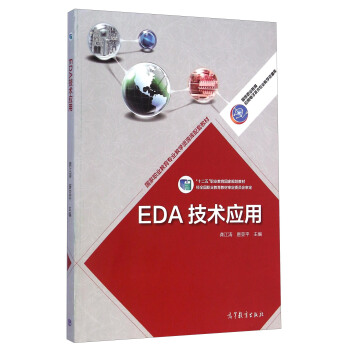

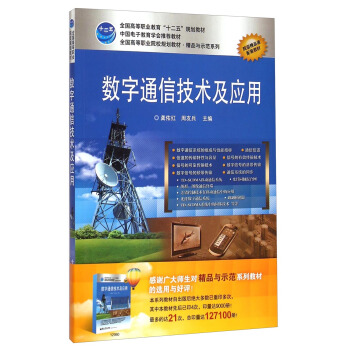
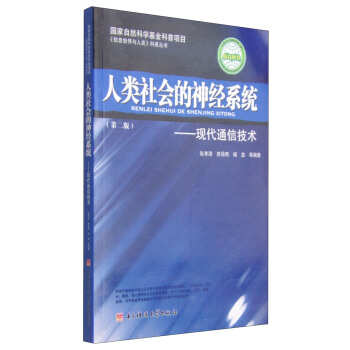
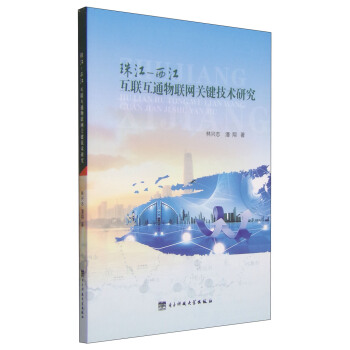


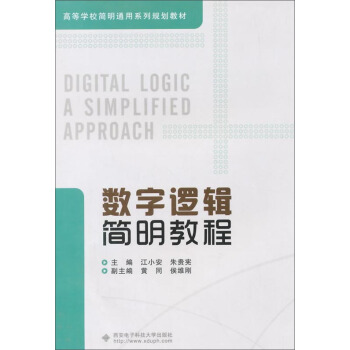
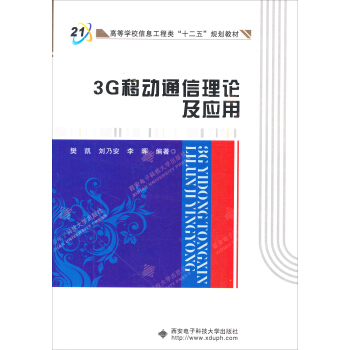

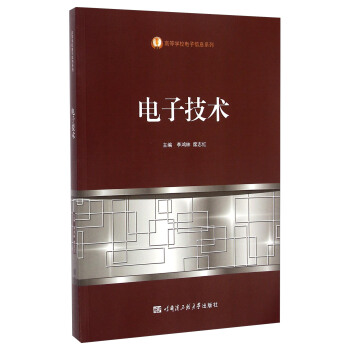
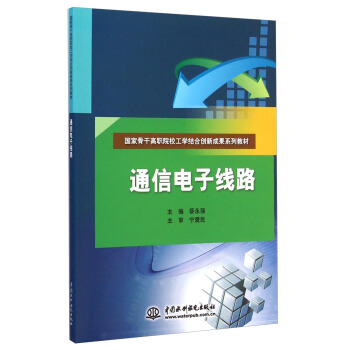
![數字電路與係統設計/21世紀高等院校信息與通信工程規劃教材 [21st Century University Planned Textbooks of Information and Communication Engineering:Digital Circuits and System Designs] pdf epub mobi 電子書 下載](https://pic.tinynews.org/11635602/554b0a7eN6a35173f.jpg)

